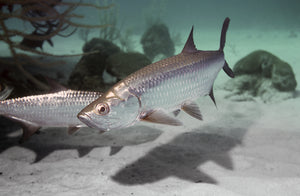As one of the most sought-after sportfish in the world, the tarpon draws serious anglers from around the globe every year. The spring tarpon run in the Gulf of Mexico signals migration and spawning season for these spectacular silver bullets and offers opportunities for some of the best tarpon fishing in Florida.
The Draw of the Tarpon
The quintessential big-game fighting fish in Florida, the tarpon is prized for its hard run and the sheer excitement of hooking it and bringing it in. Somersaulting and acrobatic leaps into the air make it a pretty impressive air show as well.
Anglers consider the tarpon one of the best fighting fish of all time, and hooking one makes for some great fish stories – and videos – to pass on time and again. Understanding their migration patterns enables anglers to follow them seasonally for the best spots to encounter them.
Gulf Coast Migration Patterns of the Tarpon
Tarpon typically spend the winter months in warm subtropical waters. But every year, when water temperatures hit the right mark, they will leave their winter residences for the coast of Florida to spawn.
In April, they begin moving north, traveling in large schools, heading up along the Atlantic and Gulf coast of Florida. Some travel as far as around the Florida panhandle and the Mississippi delta. Then they return to warmer waters in the fall. Some tarpon, however, are full time residents, so tarpon can be seen year-round in many areas of Florida.
The Best Place to Fish for Tarpon During the Migration on the Gulf Coast of Florida
The notoriously best place to seek tarpon during their migration is in Boca Grande Pass at the entry to Charlotte Harbor on Florida’s gulf coast. Fed by the Peace and Myakka Rivers, it is generally considered the largest gathering of tarpon in the world.
By April, the northern edge of the tarpon’s migration has reached the Boca Grande area, with numbers increasing daily. Large schools can be found throughout Pine Island Sound and along the beaches where they rest and feed, gathering to spawn a few weeks later in May and June.
Cycles of spawning rely on the tides and moon phases. During spawning season, tarpon can sometimes head out as far as 100 miles offshore to spawn in open water, then turn back a few days later. In the right locations, they can be seen filing off into circles called “daisy chains,” a type of mating ritual in preparation for spawning. After spawning, they return to feed once again before the migration back south for the winter.
One of the main attractions of tarpon fishing at Boca Grande can be witnessed during “hill tides,” which are some of the strongest tides of the year, produced by the new and full moon phases. During this time, millions of pass crabs are drawn to the water’s surface and can get washed out from Charlotte Harbor, causing a feeding frenzy for the tarpon. Anglers, if they are lucky, can find themselves in the middle of thousands of hungry tarpon with multiple hooking opportunities.
If You’re Headed Out On the Water, Take Reef & Reel With You
If you’re headed out for some exciting tarpon time on the gulf coast, you’ll need to gear up. That’s where we come in! Whenever you’re headed out on the water in St. Pete or anywhere along the Gulf coast, at Reef & Reel, we’ve got you covered, whether you’re looking for the best gear and tackle on the market or apparel and sunglasses to just make you look great while you’re out there.

